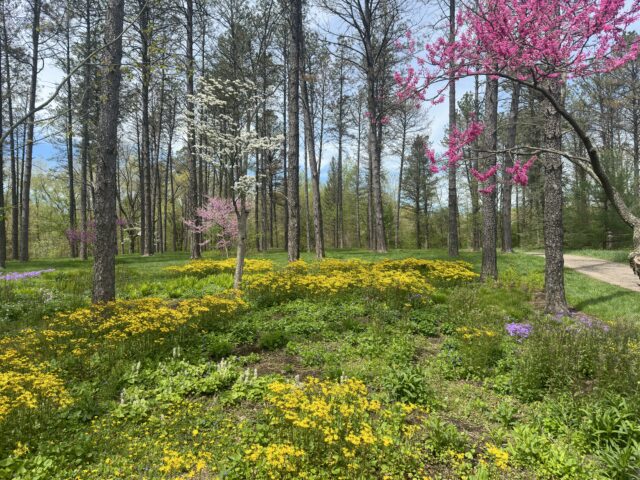
As a plant scientist I am often asked the question, “What is your favorite plant species?” The truth is, I can’t pick just one. What I love about plants is their diversity, so, this is the story of how an entire genus of plants became my favorite, and how our research on genus Rhododendron at Holden Forests & Gardens helps us to conserve biodiversity and solve the mystery as to why there are so many different kinds of plants on Earth.
To start, one might ask, what is a “genus” anyway? Most people are familiar with the term “species” to describe a group of living organisms that look similar to one another and can interbreed. A genus is just one step removed, it’s a group of species that are closely related, an extended family of many species that have traits in common.
Species in genus Rhododendron are woody plants found on acidic soils, they have funnel-shaped/tubular flowers with 5-8 petal lobes, and winged seeds that are vanishingly small. Such similarities are what allow us to recognize Rhododendron when we see it, but it turns out that there are over 900 Rhododendron species! In fact, this genus is a bona fide biodiversity champion: out of about 16,000 plant genera on Earth today, genus Rhododendron ranks 17th in having the largest number of species. That means there are more ways to be a Rhododendron than you can shake a stick at.
First and foremost, Rhododendron has incredible leaf diversity! Here, leaves from 25 Rhododendron species are placed side by side, large and small, light and dark, smooth and rough, flat and curled. That larger leaf is as big as a man’s forearm, while the smallest ones are the size of a pinky fingernail. Leaf size is important to the survival of the plant, because larger leaves can collect more light for photosynthesis in shady habitats, but these are more likely to overheat during a hot and sunny summer day, compared to a small leaf. So, the best leaf size will depend on the habitat where the plant grows.
Diversity in leaf types is one aspect that has allowed Rhododendron to occupy many different habitats all over the Earth. This map has a green dot in every location where a researcher has seen a Rhododendron. Note that most of these sightings are of plants growing in the wild, but botanical gardens are included, so some of the green dots represent cultivated plants. There are five biodiversity hotspots for genus Rhododendron:
- The Himalayan region of India and China hosts about half of the world’s Rhododendron. Down in the foothills, tall tree-like species with huge evergreen leaves like R. arboreum dot the landscape. As you move up the mountains many different species appear and disappear. Finally, at the top, low-growing species with tiny leaves hug the ground, clinging to steep, windy mountain slopes.
- Korea and Japan are hotspots for a group of Rhododendron species commonly known as the evergreen Azaleas, including kiusianum. These are small plants with tiny leaves, but they have huge multi-colored flowers and unique adaptations that allow them to thrive on harsh volcanic soils of the region.
- South East Asia including Malaysia, Indonesia, and the Philippines host about a third of the global Rhododendron. Here, epiphytic Rhododendron species like R. javanicum, commonly known as Vireyas, make their homes high up in the tropical tree canopies, living a lifestyle like that of orchids.
- North America is a hotspot of diversity for a group of Rhododendron species commonly known as Deciduous Azaleas, including prinophyllum. These tall, lanky shrubs with bright, showy flowers are tucked quietly beneath oak trees in shady coastal forests or strewn across sunny hillsides amidst scattered conifers.
- Europe hosts a handful of native species, but many sightings in this region represent either plants growing in botanical gardens or the invasive Rhododendron species ponticum, which originated in Spain but now has taken over large tracts of land in the UK by producing fast-growing, impenetrable thickets.
This amazing diversity is why I count genus Rhododendron as my “favorite plant species”, and why it became a major focus of research in my lab at Holden Forests & Gardens. Our lab investigates the role of climate in determining plant performance and survival, and how the physiological response to climate varies across populations, between species, and over time.
As one example, former intern Katiuska Hernandez investigated Rhododendron species growing in the Helen S. Layer Garden at Holden Arboretum, to see whether species with different leaf types have different strategies to survive hot summer temperatures. We found that large-leaf evergreen species like R. maximum are cautious with their water use, taking steps to keep their leaves from dehydrating as water becomes limited. On the other hand, deciduous species like R. calendulaceum supply LESS water to their leaves when water becomes limited, making it more likely that the leaves will dehydrate and die on a very hot day. Why would they do this? The answer is in the cost. Deciduous Rhododendron make their leaves smaller and more cheaply, they are made to be disposable. By disposing of the cheap leaves when stressful situations occur, this improves survival by causing the plant to go into a semi-dormant state, preventing further water loss and saving the opportunity for the plant to grow again another day. This research helps us understand what conditions are best for plant growth in our gardens and reveals the unique adaptations of each species that allow them to thrive in their diverse native habitats.
Our work also shows that adaptations that allow plants to grow happily in their native habitats can become disrupted if the climate changes too much or too fast. In fact, another trait that many Rhododendron species share in common, one that is not so fun: 70% of Rhododendron species are classified to be vulnerable, threatened, endangered or critically endangered, and 25% of species are at immanent risk of extinction.
Fortunately, in addition to conducting research on Rhododendron at Holden Forests & Gardens, we are also actively working to conserve Rhododendron species. As one example, R. calendulaceum, the flame azalea, is endangered in the state of Ohio and Holden maintains a large collection of this species, like the one shown here near Heath Pond in the Layer Garden. Holden’s collection also includes plants from different native populations, preserving local genetic diversity within species, which is an important aspect of biodiversity that opens the door for adaptation to climate change. Our research investigating the physiological and ecological diversity of Rhododendron contributes to these conservation goals, by increasing our understanding of how climate change will impact plant growth and survival, and how different species will respond.
So, now you know why I can’t choose just one favorite plant, there are so many fun plants and a lot to learn about how they make their way in the world. “Favorites” are a funny thing, aren’t they? People might question my sanity in declaring genus Rhododendron as my favorite plant species. Some might cite their love-hate relationship with that old Rhododendron plant growing in their yard – it doesn’t seem to thrive but won’t quite die either – occasionally wowing us with a grand display of spring flowers but somehow always retreating back to a scraggly mess of grey sticks and sullen leaves. Others might say that their popularity as garden plants makes them too trivial, too human for robust research questions about native biodiversity, their shrubby habits less worthy of conservation than a majestic Oak or a precious wildflower. But look just a little closer at those leaves, stretch your imagination just a little farther across the globe, and maybe you’ll see what I see.
Dr. Medeiros is a research scientist at Holden Forests & Gardens focused on understanding the complex relationship between plants and climate, particularly the role of climate variability across space and time in shaping the diversity of plant life on Earth. Her work takes an interdisciplinary approach, combining methods from physiology, ecology and evolutionary biology to conduct comparative studies using genus Rhododendron as a model system. Prior to coming to Holden, Dr. Medeiros obtained her PhD in Plant Physiological Ecology at the University of New Mexico and completed a postdoctoral appointment in Plant Evolutionary Ecology at the University of Kansas.

Juliana S. Medeiros, PhD
Plant Biologist
My research focuses on plant anatomical and physiological acclimation and adaptations to the abiotic environment. I am interested in how phenotypic and genetic variation in plant form and function interact with variation in climate over space and time to drive ecological patterns and the evolution of plant diversity. I focus primarily on plant hydraulic traits, including xylem water transport, leaf gas exchange and the integration of leaf and xylem function. Click here to learn more about research in my lab: Medeiros Lab Webpage













